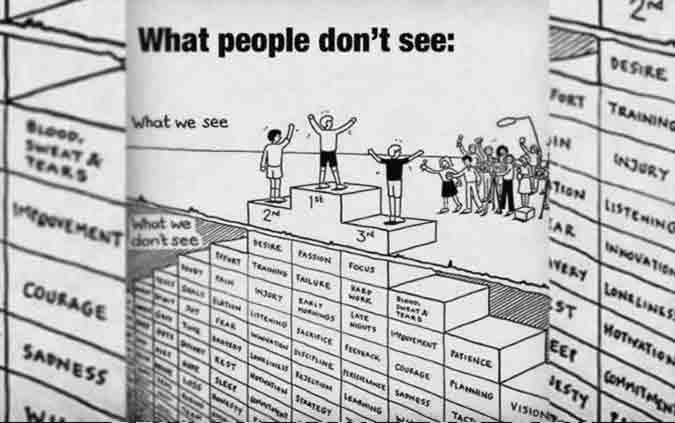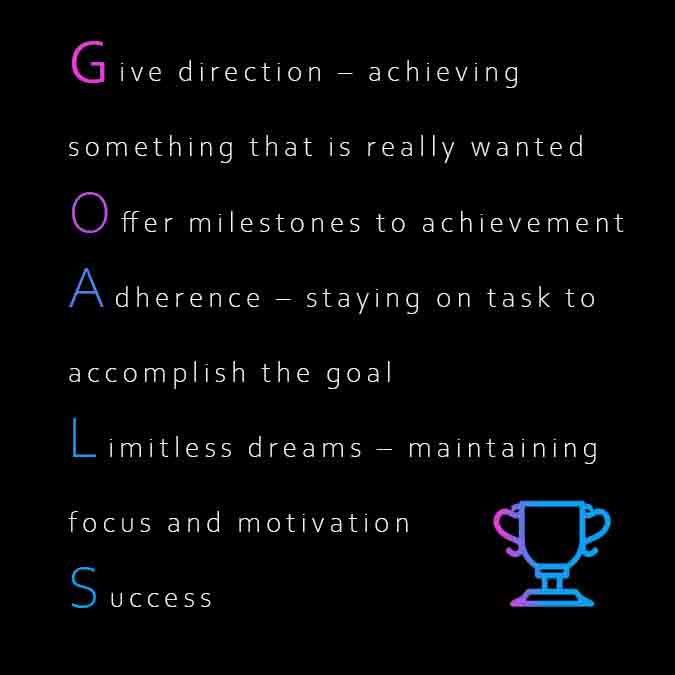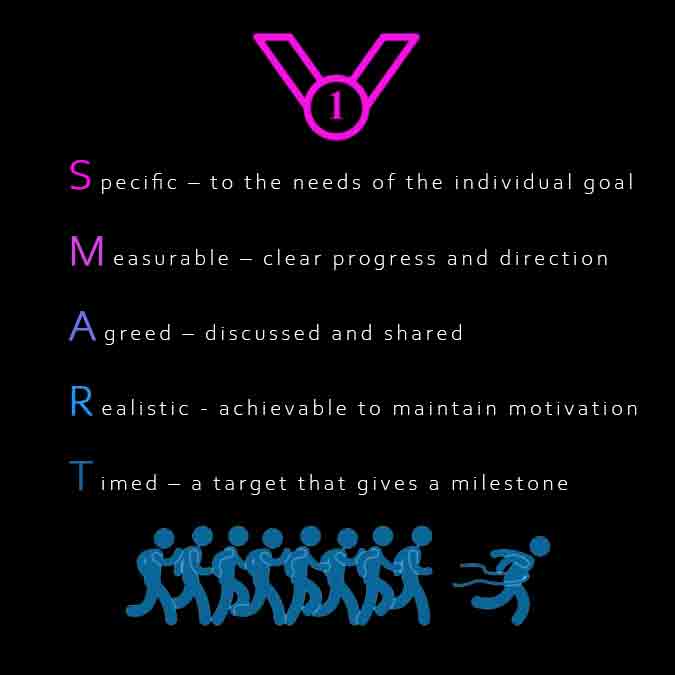
Sports psychology is the study of people and their behavior in sport.
Sports psychology is necessary to study the principles of overcoming anxiety, fears, and excitement, the athlete’s behavior in competitions, the relationship with the sports environment, coaches.
For both the athlete and coach this area is as important as physical training and performance analysis.
Success is being attributed to motivation, focus, and being in the zone, as well as team cohesion.
Goal-setting
Having goals allows participants of all abilities to stay focused, maintain motivation, and help with exercise adherence.
Setting goals offers athletes milestones to success and less active people the opportunities to improve their health and well-being.

For example, a goal could be to compete in a 5k within the month (short-term) before planning to run a marathon the following year (long-term). Goals:
- Give direction – achieving something that is really wanted
- Offer milestones to achievement
- Adherence – staying on task to accomplish the goal
- Limitless dreams – maintaining focus and motivation
- Success

Goals need to offer hope and the primary strategy for setting them is to produce SMART targets.
SMART targets give the direction of the goal and make them realistic, thus making the goals more achievable and measurable.
To make the athletes’ goals achievable, targets need to be SMART: specific, measurable, agreed, realistic and time-phased targets.
- Specific – to the needs of the individual goal
- Measurable – clear progress and direction
- Agreed – discussed and shared
- Realistic – achievable to maintain motivation
- Timed – a target that gives a milestone

Practical Application
• Goal setting should start with identifying a person’s long-term goal e.g. to represent their country in the next world championships which are to be held in 12 months’ time or to achieve a rating of 3.1 in tennis.
• This can then be broken down into an intermediate/medium-term goal (e.g. to play insufficient competitions that give opportunities to play against players with better ratings), and short-term goals (e.g. to improve the second serve as that is an area of weakness) all of which lead to the achievement of the long term goal.
• Targets/goals must be reviewed regularly.
You might like: Hard Work Is The Key To Success. Workout Quote To Change Your Life.
Duration of each cycle of Goal Setting
The duration of the cycles is very much dependent on the sport, and the competition the athlete is training for. The following timescales reflect this. A microcycle is usually between 1 to 14 days Short Term goals A mesocycle is usually between 2 weeks to 6 months Medium Term Goals A macrocycle is usually between 1 to 4 years Long Term Goals
Mental Preparation For Success.

To perform optimally, athletes need to be physically fit, technically sound, and mentally in tune. The need to stay focused and manage emotions is vital to being successful.
‘Getting into the zone’ requires the athlete to be mentally in the right place. It requires the 4 C’s.
Confidence – self-belief in your own ability. Having confidence allows the performer to focus on essential tasks. For example, a 5000m runner is confident that they have completed enough training to win their race.
Related: Health Expert: If You Want An Athletic Body – Train With Your Body Weight
Control – Control of emotions (arousal and anxiety). This is the ability of the performer to remain in control of their emotions when put under pressure. For example, a 5000m runner needs to remain in control when they find themselves ‘boxed in’ with one lap remaining in order for them to win the race.
Concentration – focused attention. If a performer concentrates on the situation at hand, they become absorbed in the competition, directing their attention to the right cues to perform well. For example, a 5000m runner would need to concentrate on the number of laps they have left and where the opposing threats are ensuring that they accelerate at the right time to win the race.
Commitment – motivation and adherence. For example, a 5000m runner is committed to long training sessions. Assessing and controlling the 4C’s can positively benefit your psychological mind-set and optimize your performance. The following strategies can help to improve the 4C’S:
- set clear performance goals
- practice imagery and visualizations
- provide positive feedback and praise
- use positive self-talk
- practice relaxation techniques.
You might like: Get Involved in Self-Organization! Be Stronger Than Your Excuses. Quote.
Imagery and mental rehearsal
Imagery and mental rehearsal can help an athlete’s motivation to succeed; they offer visualization techniques imagining successful performances. The performers can picture skills and techniques in their minds before and during the performance. For example, a triple jumper may imagine themselves performing a perfect jump in their mind.
They may repeat keywords associated with the successful execution of the jump using self-talk.
You might like: Join Team of The Most Successful Athletes and Coaches. Workout Quotes.
Motivation
Motivation can be defined as the drive to take part and persist in an activity, it is a significant factor related to sports adherence. There are two main types of motivation:
- Intrinsic internal factors enjoyment
- extrinsic external factors rewards
Intrinsic motivation
Participating in an activity for personal enjoyment without receiving an external reward for the activity itself. Taking part in the sport for the ‘feel-good factor’ is intrinsic motivation, a sense of accomplishment. Also, intrinsic motivation can be a development of knowledge and desire to improve as well as an adrenaline rush (stimulation).
Rest is as important as working hard

Extrinsic motivation
Participating in an activity due to an external influence can be in the form of tangible (physical reward – money, trophy) or intangible (non-physical – praise or coach gratification) rewards.
For the athlete to stay motivated rewards, need to be used effectively. Extrinsic motivation must be used to increase intrinsic motivation by offering information for improvement.
If an extrinsic motivator is used as a control mechanism (large sums of money), it has a detrimental effect on intrinsic motivation. Research has shown that there are four main motives as to why people participate in sport and exercise. These are:
- physical well-being
- psychological well-being
- improvement of performance
- assertive achievement i.e., accomplishing personal challenges and gaining status.
Achievement motivation
Achievement motivation is the concept that personality is linked to competitiveness; it centers on the extent to which an individual is motivated to attain success. There seem to be several types of goals against which success can be judged:
- Mastery or Task Goal – self-improvement Performance goals e.g., PB in athletics
- Ego or Ability Goals – comparison with rivals Outcome goals, e.g., winning the match
- Social Goals – social reinforcement, e.g., approval by teammates, parents, or coaches
Achievement motivation can be expressed as the personality trait that is activated by any given situation. The situation comprises of the probability of success and the intrinsic value of success.
Atkinson and McClelland (1976) stated that in any challenging situation, everyone would have both a ‘need to achieve’ (NAch) and a ‘need to avoid failure’ (NAF). Whichever feeling is the stronger will determine whether the task is accepted or declined.
In sporting situations, achievement motivation theory helps to explain performers’ behavior. For example, why some people will take chances in the bid to succeed, while others will ‘play safe’ to avoid failure.
Sporting examples
NAF behavior – a goal shooter who only attempts shots that are close to the post in netball.
NAch behavior – a tennis player who attempts to serve an ‘ace’ on their second serve when they are a breakpoint down. A coach wants an athlete with high NAch and low NAF. They can increase NAch behavior by:
• using positive reinforcement to increase feelings of pride and satisfaction
• setting tasks that have a choice of difficulty so that everyone can achieve
• trying not to put low achievers into situations where defeat is inevitable • choosing tasks that everyone can achieve but that are still sufficiently challenging
• focusing any negative feedback on effort rather than ability
• gradually increasing task difficulty as self-esteem improves.
Competitiveness – sports-specific achievement motivation Competitiveness means the motivation to achieve in sport. Research suggests that athletes favor performance goals and non-athletes outcome goals. It is essential to identify the link between competitiveness, confidence, and goal setting.
Self-confidence
Self-confidence is defined as a person’s belief that they have the ability to meet the demands of the sport/activity. High NAch personality traits offer self-belief, and coaches can influence athletes’ perceptions positively. Research regularly shows the most consistent difference between elite and less successful athletes is greater self-confidence.
Bandura called situation-specific self-confidence, self-efficacy
Self-confidence – general and stable personality trait
Self-efficacy – specific to situation and variable
Self-efficacy will determine the choice of activity, level of effort, and degree of persistence. High self-efficacy athletes are more likely to pursue challenging goals, cope with pain, and persevere through setbacks.
Self-efficacy can be developed and changed through four major types of information:
| Performance accomplishments Strategies to improve self-efficacy | Success in previous experience – in difficult tasks and early success Dependable information – facts and achievement independently is better Best effect on improving self-efficacy Tasks should be appropriate with a high probability of success |
| Vicarious experiences Strategies to improve self-efficacy | Or modeling – learn by watching a successful performance of a difficult task. This can reduce anxiety as it demonstrates a task can be completed A demonstration is very important Modeling with peers not experts |
| Verbal persuasion Strategies to improve self-efficacy | Encourage performers self-efficacy Effects are less than performance accomplishment and vicarious experiences Forms of feedback, team talks, encouragement Feedback – consistent, accurate, specific, realistic, progressive |
| Emotional arousal Strategies to improve self-efficacy | How you interpret arousal. If you fell somatic changes it might reduce self-efficacy and confidence Performers with less confidence will be hindered by arousal Anxiety reducing techniques should therefore increase self-efficacy Most difficult to change arousal levels. Knowledge and information about activity and feelings |

Practical goal setting can increase self-efficacy as long as the goals are SMART, and they must be individual.
Also, routines ensure individuals achieve control over-arousal; these routines are sometimes linked to mental rehearsal, recalling performance accomplishments.






